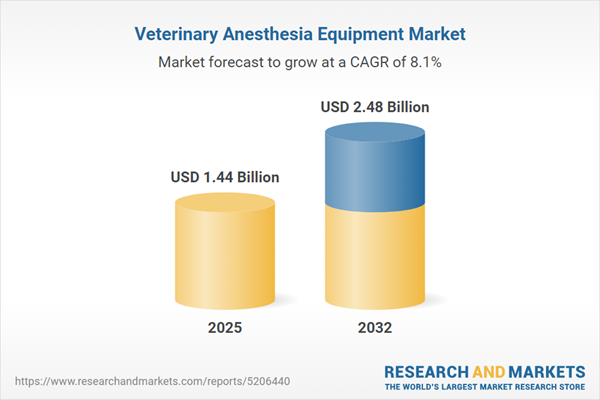Speak directly to the analyst to clarify any post sales queries you may have.
The veterinary anesthesia equipment market is experiencing consistent growth, propelled by technological advances, evolving clinical requirements, and regulatory updates that are reshaping operational standards for veterinary care providers worldwide.
Market Snapshot: Veterinary Anesthesia Equipment Market Size and Growth Outlook
The Veterinary Anesthesia Equipment Market grew from USD 1.33 billion in 2024 to USD 1.44 billion in 2025. It is expected to continue growing at a CAGR of 8.12%, reaching USD 2.48 billion by 2032. This trend highlights robust short- and long-term potential for innovators and established stakeholders seeking to capitalize on evolving clinical, operational, and compliance demands.
Scope & Segmentation
This report delivers a comprehensive analysis of the veterinary anesthesia equipment sector, detailing market composition and strategic opportunities across the following segments:
- Device Types: Anesthesia machines (including anaesthetic workstations; tabletop machines); Monitoring equipment (multi parameter monitors; pulse oximeters); Ventilators (advanced ventilators; compact ventilators).
- Animal Types: Companion animals (cats, dogs); Large animals (bovine, equine).
- End Users: Clinics (chain clinics, independent clinics); Hospitals (general veterinary hospitals, specialty veterinary hospitals); Research institutes.
- Modalities: Gas anesthesia; Injectable anesthesia.
- Sales Channels: Direct sales; Distributors.
- Regional Coverage: Americas (North America: United States, Canada, Mexico; Latin America: Brazil, Argentina, Chile, Colombia, Peru); Europe, Middle East & Africa (Europe: United Kingdom, Germany, France, Russia, Italy, Spain, Netherlands, Sweden, Poland, Switzerland; Middle East: United Arab Emirates, Saudi Arabia, Qatar, Turkey, Israel; Africa: South Africa, Nigeria, Egypt, Kenya); Asia-Pacific (China, India, Japan, Australia, South Korea, Indonesia, Thailand, Malaysia, Singapore, Taiwan).
- Key Companies: Midmark Corporation, Jorgensen Laboratories, Inc., Kent Scientific Corporation, DRE Veterinary, Inc., Eickemeyer GmbH & Co. KG, WDT eG, SurgiVet, LLC, KRUUSE A/S, Vetland Medical Equipment Co., Ltd., Mindray Bio-Medical Electronics Co., Ltd.
- Technologies Highlighted: Digital integration, closed-loop control, artificial intelligence, energy-efficient designs, portable solutions, and telemedicine platforms.
Key Takeaways for Senior Decision-Makers
- Technology-driven improvements are enabling more accurate anesthetic dosing and improved clinical monitoring, thus supporting higher standards of patient care.
- There is growing demand for modular and portable anesthesia equipment, especially for clinics serving diverse species or those offering mobile and field-based services.
- Advanced monitoring systems featuring real-time data and remote connectivity are playing a key role in expanding capabilities and operational efficiency.
- Environmental sustainability is shaping purchasing and development choices, prompting shifts toward recyclable materials, lower waste consumables, and energy-efficient systems.
- Practice management integration and telemedicine training modules broaden access to expertise, aiding facilities in emerging and under-resourced regions.
- Stakeholders are navigating more complex procurement and cost-control strategies in response to evolving supply chains and global regulatory changes.
Tariff Impact: Strategic Adjustments in Supply Chain and Pricing
The introduction of United States tariffs on key components in 2025 has led to increased production costs for anesthesia machines, monitoring devices, and ventilators. Manufacturers are responding by localizing manufacturing processes and forming regional assembly partnerships, which help reduce cost volatility and streamline delivery. Distributors and purchasers are renegotiating terms to offset the impact, with bulk buying and flexible financing models gaining importance, particularly for smaller and specialty clinics. These changes are driving greater supply chain diversification, efficient procurement practices, and a strong emphasis on collaborative supplier relationships.
Methodology & Data Sources
This analysis is grounded in extensive secondary research from peer-reviewed journals, regulatory filings, and association publications. Structured interviews with veterinarians, procurement officers, manufacturers, and distributors complement the data, applying rigorous triangulation and expert validation protocols to ensure accuracy and market relevance.
Why This Report Matters
- Offers actionable insights to guide investment in digital transformation and next-generation veterinary anesthesia solutions.
- Equips leadership teams to anticipate and manage shifts across supply chains, regulatory frameworks, and technology adoption.
- Provides comprehensive market intelligence for competitive positioning, tailored expansion strategies, and product differentiation in global and regional contexts.
Conclusion
The veterinary anesthesia equipment market presents sustained opportunities driven by innovation, supply chain optimization, and evolving clinical needs. Forward-looking organizations applying the insights from this report will be best placed to lead in capability, compliance, and patient outcomes.
Additional Product Information:
- Purchase of this report includes 1 year online access with quarterly updates.
- This report can be updated on request. Please contact our Customer Experience team using the Ask a Question widget on our website.
Table of Contents
3. Executive Summary
4. Market Overview
7. Cumulative Impact of Artificial Intelligence 2025
List of Figures
Samples

LOADING...
Companies Mentioned
The key companies profiled in this Veterinary Anesthesia Equipment market report include:- Midmark Corporation
- Jorgensen Laboratories, Inc.
- Kent Scientific Corporation
- DRE Veterinary, Inc.
- Eickemeyer GmbH & Co. KG
- WDT eG
- SurgiVet, LLC
- KRUUSE A/S
- Vetland Medical Equipment Co., Ltd.
- Mindray Bio-Medical Electronics Co., Ltd.
Table Information
| Report Attribute | Details |
|---|---|
| No. of Pages | 190 |
| Published | October 2025 |
| Forecast Period | 2025 - 2032 |
| Estimated Market Value ( USD | $ 1.44 Billion |
| Forecasted Market Value ( USD | $ 2.48 Billion |
| Compound Annual Growth Rate | 8.1% |
| Regions Covered | Global |
| No. of Companies Mentioned | 11 |








